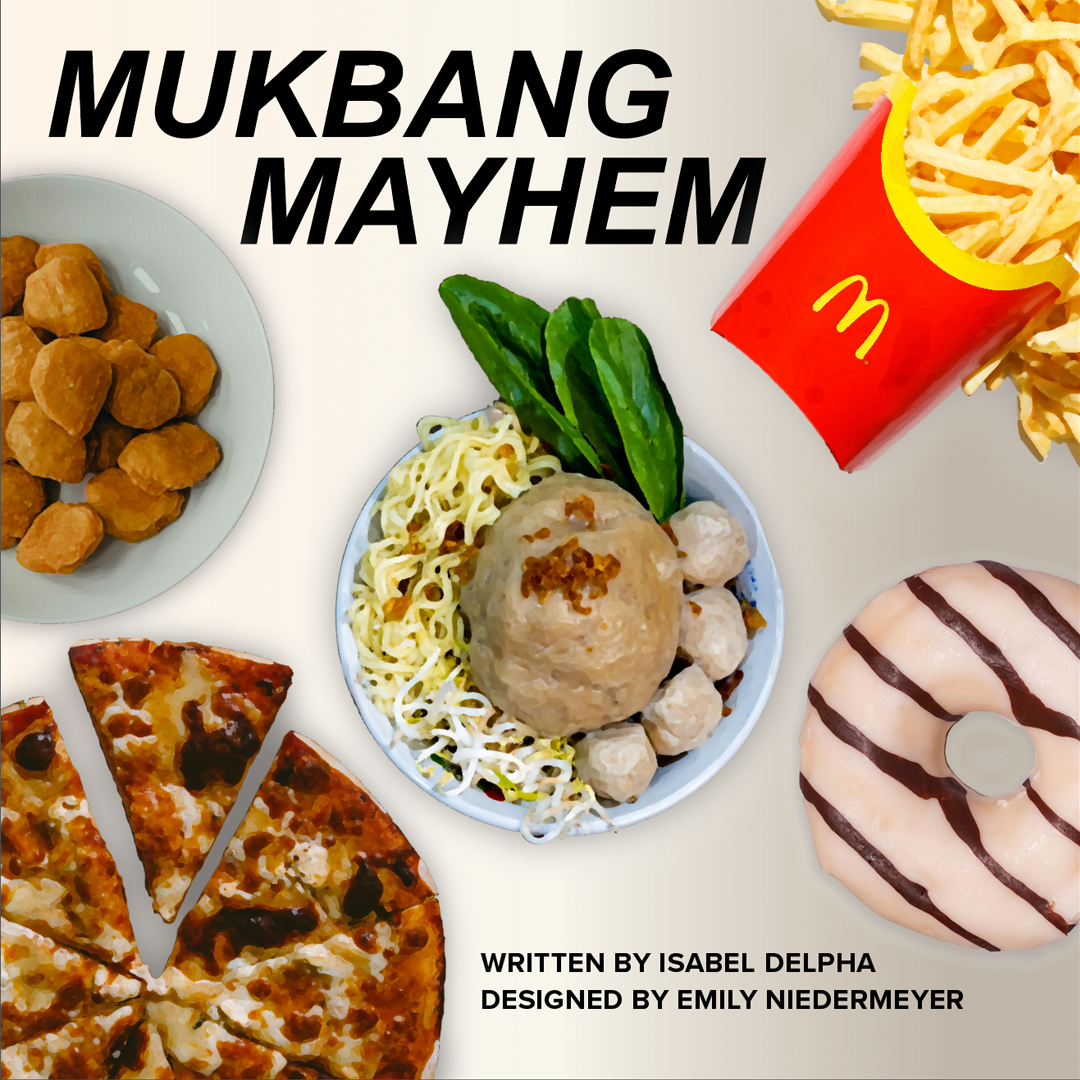
If you’re someone who’s active on social media, especially TikTok, chances are you’ve heard of the term “mukbang” before. You may even be familiar with some famous mukbang creators – names like Jelly Bean Sweets, Nikocado Avocado and That Foodie Lyss might ring a bell. But, in case you’re unfamiliar, mukbangs are videos usually posted on social media platforms such as TikTok, Instagram and YouTube that primarily feature a person eating a meal or a large amount of food. Oftentimes, the creator will address the audience in a sort of one-sided conversation, though it is also common for creators to film themselves eating in silence. ASMR mukbangs are also popular, with mukbangers intentionally chewing, slurping and crunching loudly in their videos to evoke a sensory response in their viewers.
While discussions about mukbangs have been especially abuzz recently due to controversies surrounding certain mukbang creators (more on that later), neither the term nor this genre of content is new. The term mukbang comes from the Korean word meokbang, which combines the words for “eating” and “broadcast.” The trend initially began in the form of live-stream videos in South Korea around 2014, but quickly became popular worldwide and took root in YouTube foodie communities. Popular YouTubers like Trisha Paytas only further contributed to the popularity of mukbang videos, which eventually reached short-form video platforms, namely TikTok.
But, why exactly is mukbang content so popular? People eat and witness others eat in real life so regularly that it can be hard to understand the appeal of watching videos of strangers eating online, especially since these mukbangs can be many minutes long. There are numerous reasons why this type of content resonates with such a large audience. Some of these are quite innocuous: some people simply find it entertaining to watch others eat. Viewers may find it satisfying to watch a mukbanger eat whatever food they might be craving but don’t have on hand. Some also enjoy the ASMR effect of the sounds of the mukbanger eating, especially when amplified by a nearby microphone and the creator’s efforts to cater to this effect by chewing louder than is perhaps normal. For those who live alone and typically eat alone, there is also the effect of digital commensality, the feeling of connection with others through digital media even when eating alone.
There are, however, some motivations behind the consumption of mukbang videos that are not so wholesome. While digital commensality seems like a positive effect of watching mukbang videos, repeatedly watching the same mukbangers to reduce loneliness can lead to the formation of parasocial relationships with these creators. These relationships are characterized by the viewer developing a sense of emotional connection with the creator who may share details about their life in their content but is ultimately just a stranger on the internet. More concerning yet, mukbangs are often used to fuel disordered eating habits. It’s not uncommon to find comments under mukbang videos in which viewers declare that they watched the mukbang instead of eating dinner. Treating mukbangs as meal replacements and using them to try to reduce one’s appetite are both alarmingly common practices among viewers that point to signs of eating disorders. But most unsettling is the research that shows that some mukbang viewers engage with this content due to perceived sexual connotations in the way that mukbang creators eat.
Considering these various motivations behind interacting with mukbang content, perhaps it’s unsurprising that the mukbang community has its fair share of controversy and drama. More broadly, critics of mukbangs point to the oftentimes poor and even repulsing table manners that characterize many popular mukbangs – creators stuffing their faces at an alarming speed, making messes with the food all over their hands and faces and speaking with their mouths full. Another point of criticism is that most mukbangs feature junk food and fast food, which are low in nutritional value; arguably, this promotes unhealthy eating.
Some of the mukbang controversy focuses on specific creators. Mukbanger Nikocado Avocado (Nicholas Perry) has recently received lots of attention for his drastic weight loss – going from 411 pounds at his heaviest to 158 pounds today – which he hid from the public for two years. While his audience was growing increasingly concerned with his health and speculative about his weight, Perry was strategically uploading content filmed two years in advance while undergoing his weight loss transformation in secret. Upon revealing his weight loss, he called his transformation “the greatest social experiment” of his life.
Mukbang creator Jelly Bean Sweets has likewise been attracting lots of attention as of late, and most of it is negative. Her viewers point to the shocking speed at which she consumes enormous amounts of food and note that it correlates with her apparent weight gain. Some hypothesize that she will be “the next Nikocado Avocado” and even accuse her of catering to the aforementioned viewers who find sexual pleasure in mukbangs, due to the exaggerated, messy nature of many of her mukbangs. Others defend her, saying her content is all in good fun and it’s not the internet’s place to speculate about her health.
Clearly, there’s more to the mukbang trend than just eating in front of a camera. As Nikocado Avocado said, the “world of social media is not as black-and-white as it appears.” It’s true– there’s a surprising amount of nuance to the issue of mukbangs. They arguably promote a variety of unhealthy habits but have also been found to provide a sense of community and entertainment, so it’s difficult to say whether or not the positive aspects of mukbangs outweigh the negative. Regardless, for better or for worse, it seems as though for now mukbangs are here to stay.